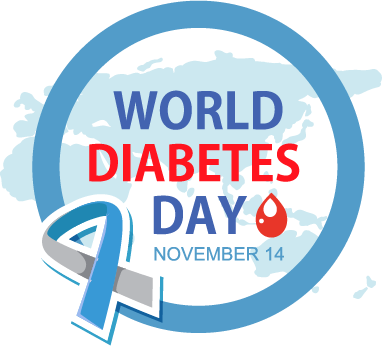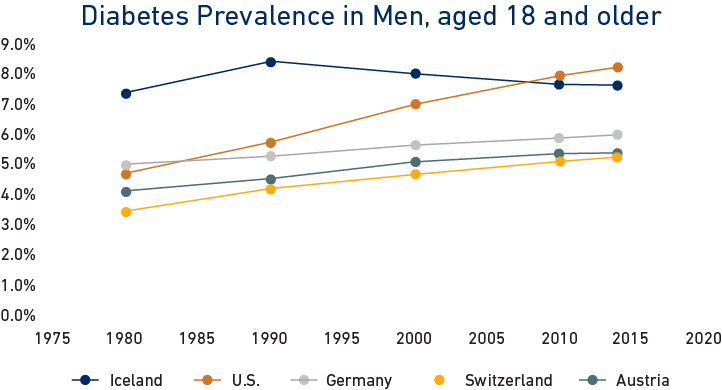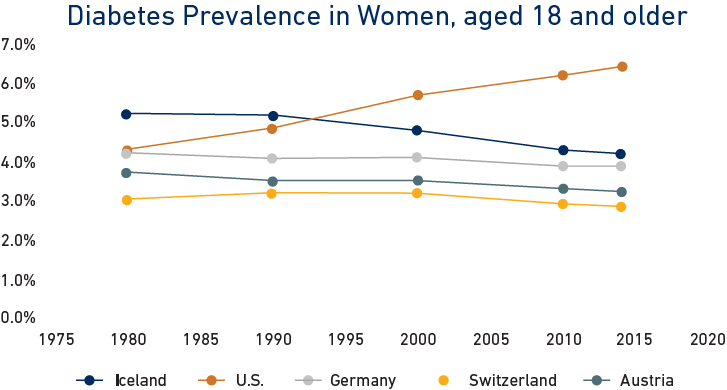World Diabetes Day
What is Diabetes?

Diabetes mellitus (DM) has become the fastest rising health crisis in the last few decades in America and globally, projecting to affect an average of 11.8% of the world’s population (1 in 8.5 adults) by 2030. DM is also the seventh leading cause of death worldwide with 5.2 million DM related deaths reported globally in 2015 and causes a significant global economic burden of 1.32 trillion US dollars. Diabetes is a chronic, long-lasting health condition that affects how your body turns food into energy (CDC, 2023).
Diabetes occurs either when insulin cannot be produced enough by the pancreas (Type 1), or when the produced insulin cannot be used effectively by the body (Type 2)(WHO, 2023). Insulin regulates glucose in the blood, and for those who have diabetes, can lead to raised blood glucose levels. Raised blood glucose can cause damage to many of the body’s systems, especially the blood vessels and nerves.
One of the more challenging aspects of DM management is diabetic foot ulcers (DFUs), which are usually quoted to occur in 15% of diabetic patients at least once in their lifetime. These are primarily neurogenic, therefore associated with poor blood sugar control, and are significantly correlated with peripheral neuropathy. A smaller subset of these ulcers also occurs in feet with malperfusion. Most major lower extremity amputations are preceded by a DFU, often with infection.In 2008, Medicare FFS reported that 4.9% of DFU beneficiaries had undergone lower extremity amputations (LEAs), 17.1% of which are second amputations, and 20.6% resulting in mortality (related to incidents of LEA).
Currently, 537 million adults are living with diabetes – approximately 1 in 10 adults. This number has risen in recent years and continues to climb, predicted to reach 643 million by 2030 and 783 million by 2045.
Currently, 537 million adults are living with diabetes
Approximately 1 in 10 adults. This number has risen in recent years and continues to climb, predicted to reach 643 million by 2030 and 783 million by 2045.


Type 1 Diabetes
Type 1 diabetes is theorized to be caused by an autoimmune reaction where the body attacks itself by mistake (CDC, 2023). This autoimmune reaction stops the body’s creation of insulin. Type 1 diabetes is non-preventable, and symptoms often develop quickly. Approximately 5-10% of those across the world with diabetes have type 1 diabetes, most of which were diagnosed as children, teens, or young adults. Those with type 1 diabetes must take insulin daily in the form of insulin shots or wearing an insulin pump.
Type 2 Diabetes
Type 2 diabetes stops the body from using insulin properly, which can lead to high levels of blood sugar if left untreated (CDC, 2023). 90-95% of people with diabetes have type 2 diabetes. Type 2 diabetes develops over many years and is usually diagnosed in adults, however, is becoming increasingly more common in children, teens, and young adults. Unlike type 1 diabetes, type 2 diabetes can be prevented or delayed with healthy lifestyle changes such as eating healthy food and being active.
Gestational Diabetes
Gestational diabetes occurs during pregnancy and is characterized by blood glucose values above normal but below the levels of type 1 and type 2 diabetes. It is estimated that about 7 to 10% of all pregnancies worldwide are affected by gestational diabetes (Amiri et al., 2019). Women with gestational diabetes are at an increased risk of complications during pregnancy and at delivery (WHO, 2023). These women, and also potentially their children, are at an increased risk to develop type 2 diabetes in the future.
| TYPE | SYMPTOMS | DEVELOPMENT | TEST |
| Type 1 | Nausea, vomiting, stomach pains | Symptoms can develop quickly and can be very severe | Blood test and sometimes autoantibody test |
| Type 2 | Extreme thirst, blurred vision, tiredness, unintentional weight loss | Symptoms often take several years to develop | Blood test |
| Gestational | Not many symptoms | Develops around the 24th week of pregnancy | Blood test |
World Diabetes Day, 2023
This year’s theme is “access to diabetes care”, highlighting the importance of prevention and response efforts
How to Observe World Diabetes Day
1. Wear a blue circle
Wear or make something with a
blue circle, the international symbol for diabetes awareness, to spread awareness and show support
2. Educate yourself and those around you
Use credible sources to educate yourself and spread awareness to those around you about what diabetes is, what it looks like, and how to get help
3. Get tested
Getting tested if you have risk
factors or symptoms of diabetes is recommended and can be incredibly beneficial in the case of an early diagnosis
Frequently asked questions
Why is November 14th diabetes Day?
In 1991, the International Diabetes Federation and the World Health Organization established World Diabetes Day (WDD) as a response to the increasing global health challenges presented by diabetes. In 2006, it gained recognition as an official United Nations Day through United Nation Resolution 61/225. Celebrated annually on November 14th, the date commemorates the birthday of Sir Frederick Banting, who, together with Charles Best, made the pivotal discovery of insulin in 1922.
What is the theme for World Diabetes Day 2023?
For 2023, the theme of World Diabetes Day is “Access to Diabetes Care.” This theme emphasizes the significance of ensuring equal access to accurate information and vital care, which is crucial for prompt treatment and effective management of diabetes.
